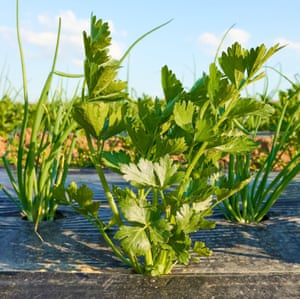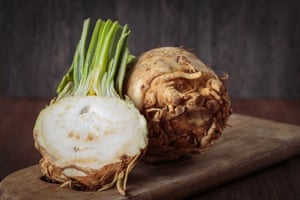Is celery a herb or a vegetable?
This versatile plant in the Apiaceae family crosses boundaries easily. It can and should be used in its entirety, and depending on which part and cultivar you use, there is one for almost every application.
It makes geographic sense that the stemming, blanched celery varieties are more commonly used in Eurocentric-dishes since that’s where they were first cultivated – originally growing very well in marshland, salt-rich soils of the Mediterranean.

Along the way some clever person figured out the practice of heavily mulching the stems to limit photosynthesis, making them sweeter and softer. This practice of limiting light, by either mounding mulch or placing a box around the crop, is very common now across a variety of crops from asparagus to puntarelle. This is also how stem celery varieties are grown commercially, so if yours at home blossom out with strong, woodier trunks don’t be disheartened, all you’ve done wrong is to grow good, strong plants that are photosynthesising.
Leafing celery varieties are more widely seen across Asian cuisines, and they have many of us stumped. What do you do with then, besides throw it in a stir fry?
The answer is to think of leafing celery like a soft herb, much like parsley and coriander. In that context, is has so many uses. There is a rainbow of leafing celery waiting for you out there: ranging in colour from yellow, pink, red to peppermint-striped.
A close relative of these leafing varieties is lovage, one of the main ingredients in Vegeta a non-MSG seasoning. All leafing varieties have a stronger celery flavour, and they’re the perfect piece to solve the puzzle of many salads, soups, noodles and braises as a finishing touch.
The other defining character of leaf celery is that it often has a hollow stem, which tends to get woody as the plant matures. Much like coriander root or celery stems, these can be thrown into a stock pot to add flavour, while the soft inner stems are perfect for cooking with.

If you want your celery baked or used as a root vegetable substitute in soups and stews, grow a monarch celeriac or any celeriac, a bulbous root celery. Though I must warn you, the slugs also love them. And while we’re in the vicinity of the oven, celery stems are a vital addition to a classic battuto or a mirepoix, which when cooked out in olive oil becomes soffrito, the basis of any decent ragù.
As for salad, pretty much all of the Apium Graveolens cultivars are up for it. Think celeriac remoulade, the crisp roots doused in a creamy, mayonnaisey, mustardy dressing. Nothing beats a fat celery with their crunchy stems – like say a Tall Utah – julienned finely, with its leaves thrown in with green apples. Coincidently, this combination also makes for a very nice, refreshing cold pressed juice too. Celery is also excellent to cut into through the fat of smoked salmon, or a worthy addition to any chicken sandwich.
Slightly torn, the leafing varieties are all fantastic to throw into a warm salad, are a great addition to any fine herb salad, or to pep up crisp lettuce leaves with a bit of intrigue.
Where I love leafing celery most is in simple noodle soups. It works nicely in a clear broth with shredded chicken or mushrooms and rice noodles, garnished with crisp garlic and shallots, then seasoned with a few drops of fish sauce and lime juice. If you start off with very good, flavourful broth this is pretty much a baseline noodle soup – anything in addition is a bonus.
In the Thai food canon, leaf celery commonly seen most in Chinese-influenced dishes, hence many noodle dishes will call for both coriander and leaf celery. It doesn’t have to be one or the other. Use both and be happily surprised by how much more flavour there is to be had.
Pork belly, celery and glass noodle stir fry
This is a lovely one pan dish which requires you have a few key pantry staples on hand, and three other ingredients for a quick midweek dinner or lunch. Use a pan that has a lid if you have one, plus a mortar and pestle comes in hand to pound the garlic, ginger and peppercorns makes things snappy.
100g pork belly with fat
5 garlic cloves
20g ginger, peeled
4 stalks of Chinese celery, save all the leaves from the bunch- pick and set aside
1/2 tsp black peppercorns
500g mung bean glass noodles
2 tbsp suet, pork fat (or duck fat, chicken smaltz, macadamia oil or whatever healthy fat you have on hand that can stand a high burning point)
2tbs Megachef premium oyster sauce
2tbs fish sauce e.g. Red Boat fish sauce
1tbs coconut nectar or palm sugar
2tbs rice wine vinegar
1 lemon/lime to serve, cut into quarters
Soak the noodles in water, then while they’re soaking peel the garlic and ginger, pound the black peppercorns until fine, then add garlic and ginger and continue pounding until a rough paste forms.
Slice strips of pork into 2cm dice leaving on fat. Julienne the celery, pick off the leaves and set aside, then drain the noodles and set aside.
Heat a pan or wok. Add fat and pork belly. Keep moving it so it doesn’t burn, then add the garlic, ginger and peppercorn paste. Cook render that down for five minutes on medium to high heat. It should start to brown and caramelise.
Add the noodles and all the seasonings. Mix well and add ½ cup of water. Cover with a lid for three minutes on high heat.
Turn off heat then add julienned celery and celery leaves.
Serve immediately with fresh lemon or lime wedge.
The Link LonkOctober 30, 2020 at 08:00PM
https://ift.tt/3kL9Aow
Herb or vegetable? Flexible celery is both and more - The Guardian
https://ift.tt/3eCf9lu
Herb
No comments:
Post a Comment